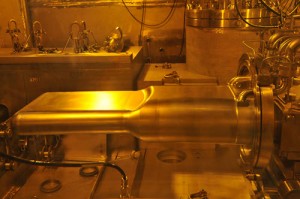
A mercury target at the Spallation Neutron Source is pictured in the target bay area during a 2009 changeout. A Oak Ridge National Laboratory spokesman said the sloped part of two SNS targets failed in September and October. (Photo courtesy of ORNL)
Its mercury targets have failed twice in the past two months, but the Spallation Neutron Source at Oak Ridge National Laboratory is available for user research again.
The program resumed at 8 a.m. Wednesday.
The $1.4 billion research facility is used to help scientists study material structures and properties.
The failures of its targets 6 and 7 in September and October have been attributed to an apparent failure in a weld joint.
“We are now trying to determine why this joint has appeared to fail, and how this apparent failure mode can be eliminated for new targets and managed for the two spare targets that are available,” according to a statement posted on the SNS website.
SNS uses an accelerator to generate pulsed proton beams that strike a mercury target in a stainless steel vessel, knocking off—or “spalling”— neutrons from the mercury atoms.
ORNL spokesman Bill Cabage said the current research cycle started Aug. 18. Target 6 showed an “end of life” failure on Sept. 22, after 690 megawatt operating hours.
SNS restarted on Oct. 6, but Target 7 indicated an “end of life” failure on Oct. 11 after 100 megawatt hours.
The previous five targets operated an average of 2,920 megawatt hours. However, the earlier targets might have operated at lower power, Cabage said.
The targets, made by private companies but built to U.S. Department of Energy specifications, cost about $1 million to change.
Cabage said the SNS has been operating at one megawatt, but would resume operations at 850 kilowatts. He said SNS began operating again on Monday as part of a “commissioning phase.”
He said SNS is trying to reduce lost research time and planning to reschedule experiments.
In the information posted on its website, SNS said user commitments would be honored as soon as possible before the end of the federal fiscal year in September 2013, but there could be about 500 fewer neutron production hours in FY 2013 than in FY 2012.
SNS will have a short shutdown during the winter holidays, but the beam for users is expected to be available shortly after the New Year through May 2013.
An annual two-month summer outage will begin in June 2013.
SNS officials said they would apply the lessons learned from the most recent shutdown “to enhance consistent and reliable operations in the future.”
“SNS is first-of-its-kind,” Cabage said. “We’re learning all the time.”
Leave a Reply